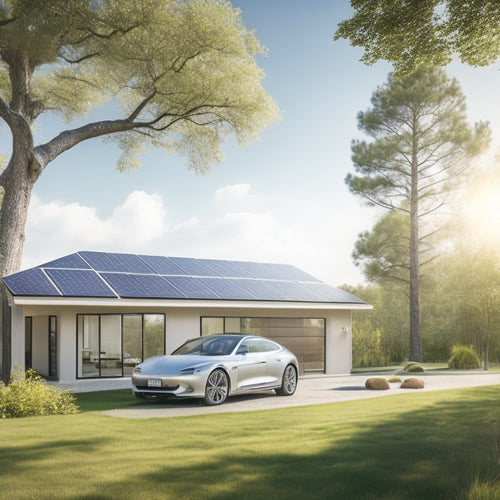
Solar Cell Efficiency in Real-World Applications
Share
You're likely dealing with solar cell efficiency that's markedly lower than advertised levels, typically ranging from 15% to 20%, due to numerous factors that come into play in real-world applications. Environmental conditions like temperature, humidity, and irradiance can reduce efficiency, while system design and maintenance also play an essential role. Proper installation and regular maintenance can enhance energy production, but shading, reflection losses, and angle of incidence can hinder it. Understanding these factors is key to optimizing your solar panel system's performance, and as you investigate these intricacies, you'll uncover opportunities to maximize your energy output and stay ahead of the curve.
Key Takeaways
- Average commercial solar panel efficiency ranges from 15% to 20%, with high-efficiency models reaching up to 22%.
- Environmental conditions like temperature, humidity, and irradiance significantly impact solar cell efficiency, with temperature being a major factor.
- Proper system design, installation, and maintenance are crucial for optimal energy production, with regular monitoring essential for identifying improvement areas.
- Residential and commercial installations have unique efficiency challenges, such as roof orientation and inverter performance, that must be addressed during design and installation.
- Emerging technologies and innovations in materials, recycling, and policy are expected to drive significant efficiency breakthroughs and increase adoption rates in the solar industry.
Understanding Solar Cell Efficiency
When you investigate the world of solar cells, understanding solar cell efficiency becomes an essential aspect. As you probe deeper, you'll realize that it's a significant factor in determining the performance of solar panels.
In simple terms, solar cell efficiency refers to the percentage of sunlight that's converted into electrical energy. Currently, the average efficiency of commercial solar panels ranges from 15% to 20%.
However, with ongoing solar technology advancements and photovoltaic material innovations, researchers are pushing the boundaries to achieve higher efficiencies. For instance, scientists have developed new materials that can capture energy from a wider range of sunlight, leading to increased efficiency.
Additionally, advancements in panel design and manufacturing processes have also contributed to improved performance.
Understanding solar cell efficiency is imperative because it directly impacts the amount of power generated by solar panels. As you consider investing in solar energy, it's essential to grasp the subtleties of efficiency and how it affects the overall performance of your system.
Efficiency in Residential Installations
Your rooftop is the perfect canvas for utilizing solar energy, and the efficiency of your residential installation plays a vital role in maximizing your energy harvest. A well-designed system can considerably reduce your residential energy bills.
However, it's important to evaluate the installation costs, which can vary depending on factors like roof orientation and inverter performance. Proper system maintenance is also vital to guarantee peak energy production.
Investing in energy storage solutions can further enhance your energy independence. Additionally, government incentives can help offset the initial investment costs.
As a homeowner, it's important to educate yourself on the benefits and challenges of solar energy. Understanding how your system works and how to maximize its performance can make a considerable difference in your energy savings.
Factors Affecting Real-World Performance
You're about to install solar panels, but you need to evaluate the factors that affect their real-world performance.
Module operating temperature, shading and reflection, and angle of incidence are key parameters that influence the actual energy output of your solar array.
As you assess these factors, you'll better understand how to optimize your system's efficiency.
Module Operating Temperature
The module's operating temperature considerably impacts its real-world performance, as it directly affects the solar cell's efficiency. You need to evaluate thermal management to enhance performance.
Temperature coefficients, which vary between cell types, determine how efficiently your solar cells convert sunlight into electricity at different temperatures. A well-designed module with effective heat dissipation mechanisms can mitigate temperature-related efficiency losses.
You should focus on module design that incorporates cooling techniques, such as passive or active cooling systems, to maintain ideal operating temperatures.
Efficiency enhancement is vital, especially in high-temperature ambient conditions. Performance metrics, like the temperature coefficient of power, help you quantify the impact of temperature on your solar panel's performance.
Shading and Reflection
Optimizing solar panel performance involves more than just managing temperature; it's also about mitigating the impact of external factors like shading and reflection.
You need to take into account the surroundings of your solar panel installation, as nearby objects or buildings can cast shadows on your panels, reducing their efficiency. A thorough shading analysis is essential to identify potential shading issues and optimize panel placement accordingly.
Reflection is another vital factor to address, as it can lead to energy losses. You can mitigate reflection by using anti-reflective coatings or applying a textured surface to the panels.
The angle and orientation of your panels also play a significant role in reducing reflection. By implementing effective reflection mitigation strategies, you can minimize energy losses and maximize your solar panel's performance.
Angle of Incidence
Every degree counts when it comes to the angle of incidence, a critical factor affecting real-world solar panel performance. You need to verify your solar panels are installed at the ideal orientation to maximize sunlight exposure and efficiency.
A slight deviation from the perfect incidence angle can lead to significant performance variation. Solar tracking systems can help you adjust the angle of your panels to compensate for the sun's movement, but they come at an additional cost.
Even without tracking, you can still achieve efficiency maximization by using installation techniques that take into account the local solar irradiance patterns. When planning your solar installation, consider the angle adjustment needed to enhance energy output.
A well-designed system can mitigate the effects of suboptimal incidence angles, but it's still crucial to get it right. Remember, every degree of deviation from the ideal orientation can result in lost energy and revenue.
Commercial Solar Panel Efficiency
Most commercial solar panels boast an efficiency rating between 15% and 20%, with a few high-end models reaching up to 22%.
When evaluating commercial solar panels, you should consider factors beyond just efficiency ratings. You'll want to assess the energy conversion capabilities of the solar technology, as well as the cost analysis of the system. Market trends indicate that high-efficiency panels are becoming more cost-competitive, making them a viable option for businesses and organizations.
Proper installation practices are essential to guarantee peak performance metrics. You should also consider the product lifespan, which can range from 25 to 30 years or more, depending on the manufacturer and maintenance strategies.
Policy impacts, such as incentives and tax credits, can also affect the viability of commercial solar installations. As you investigate commercial solar options, be aware of consumer awareness campaigns that promote high-efficiency products, and evaluate the claims with a critical eye.
Efficiency in Off-Grid Systems
As you venture into off-grid systems, you're likely to encounter unique efficiency challenges. Off-grid benefits, such as energy independence, come with the need for careful system sizing and load management. This is vital to guarantee that your renewable resources can meet your energy demands.
Battery integration is also key, as it allows you to store excess energy for later use. However, this adds complexity to your system, requiring careful maintenance strategies to prevent degradation.
Economic considerations also play a significant role in off-grid systems. The initial investment in your solar array and battery bank can be substantial, so it's important to weigh the costs against the benefits of energy independence.
Installation challenges, such as remote locations and harsh environmental conditions, must also be factored into your planning. Finally, performance monitoring is critical to identify areas for improvement and optimize your system's efficiency.
Impact of Climate on Efficiency
Three key climate factors - temperature, humidity, and irradiance - greatly impact the efficiency of solar cells. You need to take into account these factors when installing and maintaining your solar panel system to guarantee peak performance.
Climate variability and weather patterns can greatly influence your system's energy output. For instance, high temperature extremes can reduce efficiency by up to 0.5% per degree Celsius.
Here are 4 ways humidity levels and atmospheric conditions can impact your system:
- Humidity: High humidity levels can lead to increased temperature and reduced efficiency.
- Atmospheric conditions: Pollution effects, such as dust and smog, can reduce irradiance and lower efficiency.
- Seasonal changes: Changes in irradiance and temperature between summer and winter can affect your system's performance.
- Geographic factors: Installation location and surrounding environment can influence your system's exposure to climate factors.
Understanding these climate-related factors is essential for maximizing your solar panel system's efficiency and guaranteeing reliable energy production.
Future of Solar Cell Efficiency
You've optimized your solar panel system to mitigate the impact of climate factors, but what's on the horizon for solar cell efficiency? Emerging technologies and innovative materials are ready to drive efficiency breakthroughs. Advances in recycling methods will reduce waste and decrease production costs.
Additionally, innovative materials will enhance energy storage capabilities, further increasing overall efficiency. Policy implications will play a crucial role in shaping market trends, with cost reduction being a key driver.
As installation practices continue to improve, performance monitoring will become even more critical. You can expect to see major progress in efficiency gains, leading to increased adoption rates.
The future of solar cell efficiency is bright, with researchers and manufacturers pushing the boundaries of what's possible. As the industry continues to evolve, you'll need to stay informed about the latest developments to maximize your solar panel system's performance.
Frequently Asked Questions
Can Solar Panels Work During a Power Outage?
You might think solar panels are useless during a power outage, but you're wrong - with energy storage and grid independence, your solar panels can continue generating power, keeping you lit and connected when the grid fails.
How Often Should I Clean My Solar Panels?
You should clean your solar panels regularly as part of panel maintenance, ideally every 6-12 months, to guarantee ideal energy output, depending on local environmental conditions and cleaning frequency to maximize power generation.
Do Solar Panels Void My Roof's Warranty?
Like a skilled builder, you carefully construct your home's energy future, but do solar panels void your roof's warranty? Not necessarily; installation impacts are typically covered, but warranty coverage may vary, so review your contract to guarantee a clear understanding of the terms.
Can I Use Solar Panels With a Septic System?
When you decide to install solar panels, you'll need to take into account solar panel placement to avoid shading or damage from your septic system; regular septic system maintenance is essential to prevent backup risks and guarantee a safe, efficient energy setup.
Are Solar Panels Compatible With All Roof Types?
Fasten your Tudor-style doublet, mate! You're wondering if solar panels are compatible with all roof types. Thankfully, modern installation methods adapt to various roof materials, such as asphalt shingles, metal, and clay tiles, ensuring a secure and efficient fit for your energy-hungry abode.
Related Posts
-

Why Invest in Solar Car Battery Chargers Online?
By investing in a solar car battery charger online, you're not only reducing your reliance on fossil fuels but also o...
-

Top Portable Solar Panels for Cars to Buy Online
When shopping for portable solar panels for your car, you'll want to take into account reputable brands like Renogy, ...
-

What Are the Average Cost Savings of Solar Panels
You can expect to save between $400 and $1,000 per year on your electricity bills with solar panels, which translates...


